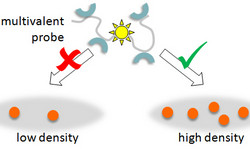Multivalency in biological systems – towards new concepts for clinical intervention
Multivalent interactions are extremely common and important in biological systems. Characterised by the simultaneous binding of multiple ligands on one biological molecule to multiple receptors on another, they can be much stronger than their corresponding monovalent interactions. As such, their agonistic actions, where a biological response is activated, and antagonistic actions are fundamentally different from their monovalent counterparts. Despite their relevance in biological systems, we still have no good understanding of how multivalent interactions confer biological function. The CELLMULTIVINT (Combining supramolecular chemistry, physico-chemical characterization and theoretical modeling to understand multivalent interactions at the cell-hyaluronan matrix interface) project has overturned the limitations of previous research. The researchers developed well-defined, highly specific and tuneable model systems to study multivalent binding of polymers and proteins to functional surfaces. Using this platform and hyaluronan, an important biological polymer, they provided the first evidence of ‘superselectivity’ in multivalent binding. Superselectivity is the ability to sharply discriminate cells by their surface density of receptors. Results of this research have been published in J. Am. Chem. Soc. Specifically, the researchers found that the surface density of bound polymer increases faster than linearly with the surface density of binding sites. Using concepts from soft matter physics, they showed that superselectivity is a result of multivalency and is enhanced by the ability of polymers to interpenetrate. By combining data from the tuneable experimental system with theoretical modelling and simulations, CELLMULTIVINT demonstrated how molecular characteristics such as size, valency and affinity can be adjusted to tune superselective binding. Project research results have laid the foundations for the design of multivalent probes for biomedical applications, a prime example being polymeric drug designed for selective cell targeting. Other developments could include modulation of cell signalling and immune reactions as well as toxin and pathogen inhibition.







